Henry Hastings Sibley
| Henry Hastings Sibley | |
|---|---|
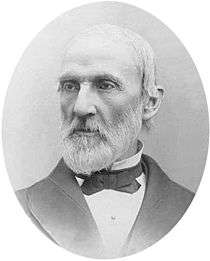 | |
| 1st Governor of Minnesota | |
|
In office May 24, 1858 – January 2, 1860 | |
| Lieutenant | William Holcombe |
| Preceded by |
Samuel Medary as Territorial Governor |
| Succeeded by | Alexander Ramsey |
| Member of the U.S. House of Representatives from Minnesota Territory's at-large district | |
|
In office July 7, 1849 – March 3, 1853 | |
| Preceded by | New district |
| Succeeded by | Henry Mower Rice |
| Member of the U.S. House of Representatives from Wisconsin Territory's at-large district | |
|
In office October 30, 1848 – March 3, 1849 | |
| Preceded by | John H. Tweedy |
| Succeeded by | District abolished |
| Personal details | |
| Born |
February 20, 1811 Detroit, Michigan |
| Died |
February 18, 1891 (aged 79) Saint Paul, Minnesota |
| Political party | Democratic |
| Spouse(s) | Sarah Jane (Hume) Steele |
| Profession | supply-purchasing agent |
| Signature |
|
| Military service | |
| Allegiance |
United States of America Union |
| Service/branch |
United States Army Union Army |
| Years of service | 1862–1866 |
| Rank |
|
| Commands | District of Minnesota |
| Battles/wars |
American Civil War Dakota War of 1862 |
Henry Hastings Sibley (February 20, 1811 – February 18, 1891) was the first Governor of the U.S. state of Minnesota and a U.S. Representative of the Minnesota Territory and the Wisconsin Territory.
Early life and education
Henry Hastings Sibley was born in Detroit, Michigan, where his parents, Solomon Sibley (1769–1846), a native of Sutton, Massachusetts, and Sarah Whipple (Sproat) Sibley had moved in 1797. It was part of a major westward migration after the American Revolutionary War by New Englanders. Solomon Sibley became a prominent judge in the early history of the city and state. He was of entirely English ancestry, all of which had been in North America since the early 1600s.[1]
As a young man, Henry Sibley read about and studied law in his father's office to prepare for the bar and licensing.
Career
In 1828, the young Sibley started as a clerk at a mercantile house in Sault Ste. Marie, a prominent fur trading center on both the United States and Canadian sides. From 1829–1834, he worked as a supply-purchasing agent of the American Fur Company at Mackinac. In 1834, Sibley became a partner in the company and relocated to their headquarters in St. Peter's (now called Mendota), Minnesota. He lived there from 1834–1862.[2]
Marriage and family
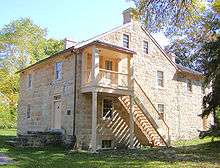
In 1836, Sibley built the first stone house in Minnesota, which is now the Sibley House Historic Site. The home, in Mendota, overlooked Fort Snelling from across the Mississippi River. Over the winter of 1839-40 he entered a de facto marriage with Red Blanket Woman, granddaughter of a Mdewakanton Dakota chief; a daughter, Helen Hastings Sibley, also known as Wahkiyee (Bird), was born in August 1841. The circumstances of Sibley and Red Blanket Woman's relationship are obscure, but several sources suggest that she remarried a Dakota man, perhaps in 1842, and died in early 1843.[3]
On May 2, 1843, Sibley married Sarah Jane Steele, daughter of General James Steele, commander of Fort Snelling, and his wife Mary (Hume). Sarah Jane's brother was Franklin Steele, a prominent Minneapolis businessman, and her sister Anna Abby Steele married Dr. Thomas R. Potts, who later became the first mayor of St. Paul, Minnesota. For her part, Helen was eventually placed with a missionary family and grew up acculturated to white society in St. Paul; Sibley maintained a congenial and public relationship with Helen until her death in 1859, although this reportedly upset Sarah.[4]
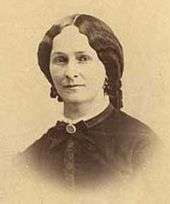
The political boundaries changed so frequently from 1836 through 1862 that, although all of Sibley's white children were born in this house, they were each recorded as having been born in different political units: Michigan, Wisconsin, Iowa, Minnesota Territory and finally, the state of Minnesota. In 1862, the Sibley family moved to St. Paul.
Political career
Sibley started his public career shortly after the organization of Iowa Territory, receiving a commission as Justice of the Peace of Clay County by governor John Chambers.[5] He received commissions and extensions to his commission in 1838, 1839 and 1840.[6]
Sibley's political life began when he was elected to represent Wisconsin Territory to the 30th United States Congress in an unusual organizational vacuum after Wisconsin became a state on May 29, 1848. His election was mandated to fill the vacancy caused by the resignation of John H. Tweedy. He took over as the Wisconsin Territory At-large congressional district representative on October 30, 1848, although he was not recognized to be seated until the subsequent January. The Wisconsin Territory's At-large congressional district was eliminated with the creation of the Territory of Minnesota on March 3, 1849.[7] He was subsequently elected as the first representative of the Minnesota Territory's At-large congressional district, serving in the 31st and 32nd congresses from July 7, 1849 - March 3, 1853.
Sibley was elected to the Minnesota Territorial House of Representatives, convened from January to March 1855, as the representative of Dakota County. He was a member of the Democratic Party wing of the first Minnesota Constitutional Convention, of which he eventually became president. Assembled July 13, 1857, the convention resulted in adoption of the constitution as framed on October 13, 1857.[8]
In 1858 Sibley was elected as the first governor of the state, and is one of just four Minnesota Democrats to win a gubernatorial election with a Democrat in the White House.[9] He served from May 24, 1858, until January 2, 1860.[10] After narrowly defeating Republican Alexander Ramsey in the first state gubernatorial contest, Sibley declared in his inaugural address, "I have no object and no interests which are not inseparably bound up with the welfare of the state." He did not seek reelection.
Railroad bond issue
When the legislature voted for the state to issue bonds to the railroads to provide for construction of the transcontinental route, Sibley refused. He said the railroads did not give priority of lien to the state on their property. The state supreme court ordered the governor to issue the legislatively authorized state bonds to railroads. The legislature asked him to market the bonds in New York. Although he made an effort to do, the capitalists refused to buy the bonds. The state subsequently repudiated the issuance.[11]
Military career
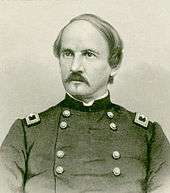
In 1862, after the American Civil War began, Sibley was appointed colonel of the state militia. He was directed to the upper Minnesota River to protect exposed settlements from the Sioux American Indians. After the massacre at Acton, August 18, 1862, he was involved in the following engagements:
The last engagement was a decisive battle. It resulted in Sioux bands' releasing about 250 captive whites. In the action, the militia captured 2,000 Sioux, both men and women. Of these captives, 321 warriors were tried for capital crimes and 303 were sentenced to death. It was a "kangaroo court" with no lawyers for the defendants. Some of the "trials" lasted only a few minutes. Thirty-eight men were hanged at Mankato, December 26, 1862, including at least one whose sentence had been commuted by President Lincoln.[12]
For gallantry in the field, Sibley was promoted to brigadier-general of volunteers, September 29, 1862. In 1863, he led a second successful expedition against the Sioux in Dakota Territory. This campaign included the battles of Big Mound (July 24), Dead Buffalo Lake (July 26), and Stony Lake (July 28).
Sibley continued to defend the western frontier, 1864–1865. On November 29, 1865, he was brevetted as major-general of the volunteers for "efficient and meritorious services." He was relieved from the command of the district of Minnesota in August 1866 after the end of the American Civil War.
Post-military career
After his military service, Sibley was active in settling several Indian treaties. Upon reentering business life in St. Paul, he served as president of the chamber of commerce, as well as the president of several railroads, banks, and other large corporations.
He also served a variety of civil organizations. He became a member of the Minnesota Historical Society in 1849 and eventually served as president. He joined the Old Settlers' association of that state in 1858. He contributed to the collections of the Minnesota Historical Society, to Spirit of the Times, and to The Turf, Field and Farm. Among his work for the Minnesota Historical Society were memoirs of Joseph Nicolas Nicollet,[13] Hercules L. Dousman[14] and Jean Baptiste Faribault.[15]
He died in St. Paul, Minnesota on February 18, 1891, two days before his 80th birthday and is buried in Oakland Cemetery in St. Paul.
Legacy and honors
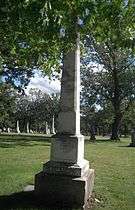
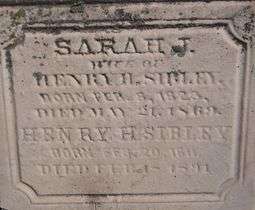
- In 1867 he was appointed to the board of visitors to the U.S. Military Academy at West Point.
- He was also president of the board of regents of the University of Minnesota, and president of the Board of Indian Commissioners from 1875–1876.
- He was awarded an honorary LL.D. from the College of New Jersey (later known as Princeton University), in 1888.
- Sibley was memorialized in numerous place names, including: Sibley County, Minnesota,[16] Sibley, North Dakota, Sibley, Iowa, Hastings, Minnesota,[17] Sibley State Park, and Henry Sibley High School in Mendota Heights, Minnesota.
See also
Notes
- ↑ The ancestry, life, and times of Hon. Henry Hastings Sibley By Nathaniel West page 4
- ↑ Wisconsin Magazine Of History Archives. Wisconsinhistory.org. Retrieved on 2011-09-10.
- ↑ Jane Lamm Carroll, "Who Was Jane Lamont?: Anglo-Dakota Daughters in Early Minnesota," Minnesota History, Spring 2005, 192-193. http://collections.mnhs.org/MNHistoryMagazine/articles/59/v59i05p184-196.pdf
- ↑ Jane Lamm Carroll, "Who Was Jane Lamont?, 193-194
- ↑ Sibley, Henry H. (1880). "Reminiscences of the Early Days of Minnesota". Retrieved August 18, 2014.
- ↑ Shortridge, Wilson P. (August 1919). "Henry Hastings Sibley and the Minnesota Frontier". Minnesota History Bulletin. 3 (3): 115–125. Retrieved August 19, 2014.
- ↑ Butterfield, Consul Willshire (1884). History of Crawford and Richland Counties, Wisconsin. Springfield, IL: Union Publishing Company. p. 41. Retrieved August 18, 2014.
- ↑ Henry Hastings Sibley, Minnesota Research Reference Library-Legislators Past and Present. Leg.state.mn.us. Retrieved on 2011-09-10.
- ↑ Ostermeier, Eric (December 6, 2013). "Can Dayton Catch Lightning in a Bottle Twice?". Smart Politics.
- ↑ Lawrence Kestenbaum. "Index to Politicians: Siaca to Sifford". The Political Graveyard. Retrieved 2010-07-20.
- ↑ The Henry Hastings Sibley papers-Minnesota Historical Society
- ↑ Elder, Robert (2010-12-13) Execution 150 Years Ago Spurs Calls for Pardon, New York Times
- ↑ Memoir of Jean N. Nicollet Note that the name "Jean" in the article (and its title) is wrong, but it is not known if the mistake belongs to Sibley or a later editor. Nicollet's first name was Joseph.
- ↑ Memoir of Hercules L. Dousman
- ↑ Memoir of Jean Baptiste Faribault
- ↑ Upham, Warren (1920). Minnesota Geographic Names: Their Origin and Historic Significance. Minnesota Historical Society. p. 518.
- ↑ Gannett, Henry (1905). The Origin of Certain Place Names in the United States. Govt. Print. Off. p. 152.
Other references
- Henry Hastings Sibley, Biographical information, Minnesota Historical Society
- Gubernatorial records, Minnesota Historical Society
- Henry Hastings Sibley Papers, Minnesota Historical Society
- Rossiter, John (1906). "Henry Hastings Sibley". Biographical Dictionary of America. IX. Boston: American Biographical Society. Retrieved August 18, 2014.
- Pedersen, Kern Owen (1949). Makers of Minnesota: An Illustrated Story of the Builders of Our State. St. Paul, MN: Pederson. Retrieved August 19, 2014.
- Williams, John Fletcher (1894). "Henry Hastings Sibley: A Memoir". Collections of the Minnesota Historical Society. Minnesota Historical Society. 6: 257–310. Retrieved August 19, 2014.
External links
- United States Congress. "Henry Hastings Sibley (id: S000396)". Biographical Directory of the United States Congress. Retrieved on 2008-12-01
| United States House of Representatives | ||
|---|---|---|
| Preceded by John H. Tweedy |
Member of the U.S. House of Representatives from Wisconsin Territory's at-large congressional district October 30, 1848 – March 3, 1849 |
District abolished |
| New district | Member of the U.S. House of Representatives from Minnesota Territory's at-large congressional district July 7, 1849 – March 3, 1853 |
Succeeded by Henry Mower Rice |
| Political offices | ||
| Preceded by Samuel Medary as Territorial Governor |
Governor of Minnesota 1858–1860 |
Succeeded by Alexander Ramsey |
